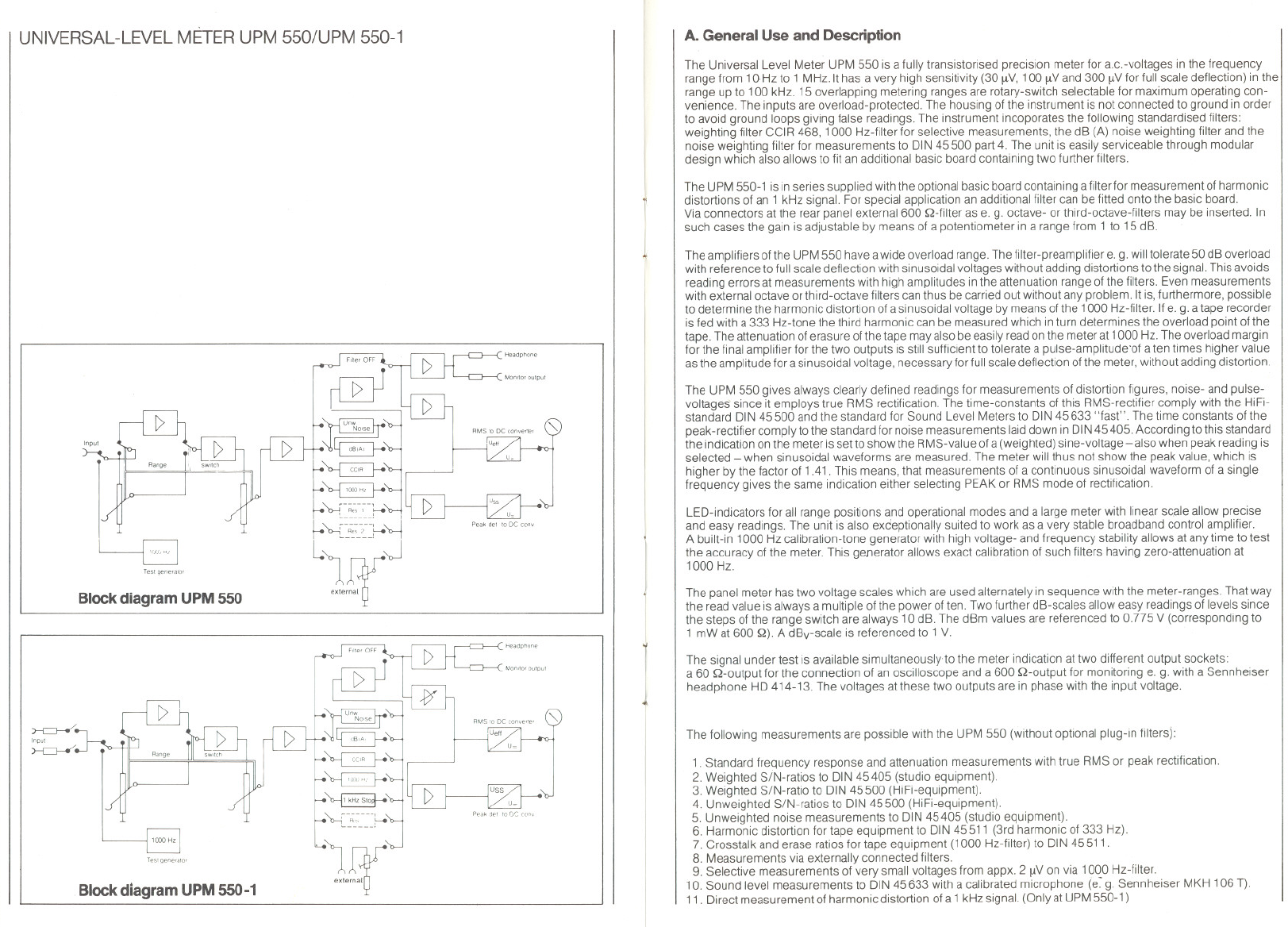
UNIVERSAL-lEVEL METER UPM 550/UPM 550-1
A. General Use and Description
The Universal Level Meter UPM 550 is a fully transistorised precision meter for a.c.-voltages in the frequency
range from 10Hz to 1 MHz.lt has a very high sensitivity (30 ~V, 100 ~V and 300 ~V for full scale deflection) in the
range up to 100 kHz. 15 overlapping mete ring ranges are rotary-switch selectable for maximum operating con-
venience. The inputs are overload-protected. The housing of the instrument is not connected to ground in order
to avoid ground loops giving false readings. The instrument incoporates the following standardised filters:
weighting filter CCIR 468, 1000 Hz-filter for selective measurements, the dB (A) noise weighting filter and the
noise weighting filter for measurements to DIN 45500 part 4. The unit is easily serviceable through modular
design which also allows to fit an additional basic board containing two further filters.
I
1
The UPM 550-1 is in series supplied with the optional basic board containing afilterfor measurement of harmonic
distortions of an 1 kHz signal. For special application an additional filter can be fitted onto the basic board.
Via connectors at the rear panel external 600 Q-filter as e. g. octave- or third-octave-filters may be inserted. In
such cases the gain is adjustable by means of a potentiometer in a range from 1to 15 dB.
""dpM"
The amplifiers ofthe UPM 550 have a wide overload range. The filter-preamplifier e. g. will tolerate 50 dB overload
with reference to full scale deflection with sinusoidal voltages without adding distortions to the signal. This avoids
reading errors at measurements with high amplitudes in the attenuation range of the filters. Even measurements
with external octave or third-octave filters can thus be carried out without any problem. It is, furthermore, possible
to determine the harmonic distortion of asinusoidal voltage by means of the 1000 Hz-filter. If e. g. atape recorder
is fed with a 333 Hz-tone the third harmonic can be measured which in turn determines the overload point of the
tape. The attenuation oferasure ofthe tape mayaiso be easily read on the meter at 1000 Hz. The overload margin
for the final amplifier for the two outputs is still sufficient to tolerate a pulse-amplitude'of a ten times higher value
as the amplitude for a sinusoidal voltage, necessary for full scale deflection of the meter, without adding distortion.
Mo""""",
The UPM 550 gives always clearly defined readings for measurements of distortion figures, noise- and pulse-
voltages since it employs true RMS rectification. The time-constants of this RMS-rectifier comply with the HiFi-
standard DIN 45500 and the standard for Sound Level Meters to DIN 45633 "fast". The time constants of the
peak-rectifier comply to the standard for noise measurements laid down in DIN 45405. According to this standard
the indication on the meter is set to show the RMS-value of a (weighted) sine-voltage-also when peak reading is
selected - when sinusoidal waveforms are measured. The meter will thus not show the peak value, which is
higher by the factor of 1.41. This means, that measurements of a continuous sinusoidal waveform of a single
frequency gives the same indication either selecting
PEAKor RMS mode of rectification.
T",g"""'O,
LED-indicators for all range positions and operational modes and a large meter with linear sC,aleallow precise
and easy readings. The unit is also exeeptionally suited to work as a very stable broadband contra I amplifier.
A built-in 1000 Hz calibration-tone generator with high voltage- and frequency stability allows at any time to test
the accuracy of the meter. This generator allows exact calibration of such filters having zero-attenuation at
1000 Hz.
~
Block diagram UPM 550
The panel meter has two voltage scales which are used alternately in sequence with the meter-ranges. That way
the read value is always a multiple of the power of ten. Two further dB-scales allow easy readings of levels since
the steps of the range switch are always 10 dB. The dBm values are referenced to
0.775 V (correspondingto
1 mW at 600 Q). A dBv-scale is referenced to 1 V.
""dp'gg,
Mo""'"""
The signal under test is available simultaneouslyto the meter indication at two different output sockets:
a 60 Q-output for the connection of an oscilloscope and a 600 Q-output for monitoring e. g. with a Sennheiser
headphone HD 414-13. The voltages at these two outputs are in phase with the input voltage.
The following measurements are p08sible with the UPM 550 (without option al plug-in filters):
T",g'""co,
1. Standard frequency response and attenuation measurements with true RMS or peak rectification.
2. Weighted S/N-ratios to DIN 45405 (studio equipment).
3. Weighted S/N-ratio to DIN 45500 (HiFi-equipment).
4. Unweighted S/N-ratios to DIN 45500 (HiFi-equipment).
5. Unweighted noise measurements to DIN 45405 (studio equipment).
6. Harmonic distortion for tape equipment to DIN 45511 (3rd harmonic of 333 Hz).
7. Crosstalk and erase ratios for tape equipment (1000 Hz-filter) to DIN 45511.
8. Measurements via externally connected filters.
9. Selective measurements of very small voltages from appx. 2 ~V on via 1000 Hz-filter.
10. Sound level measurements to DIN 45633 with a calibrated microphone (e~g. Sennheiser MKH 106 T).
11. Direct measurement of harmonic distortion of a 1 kHz signal. (Only at UPM 550-1)
Block diagram UPM 550-1
I
















